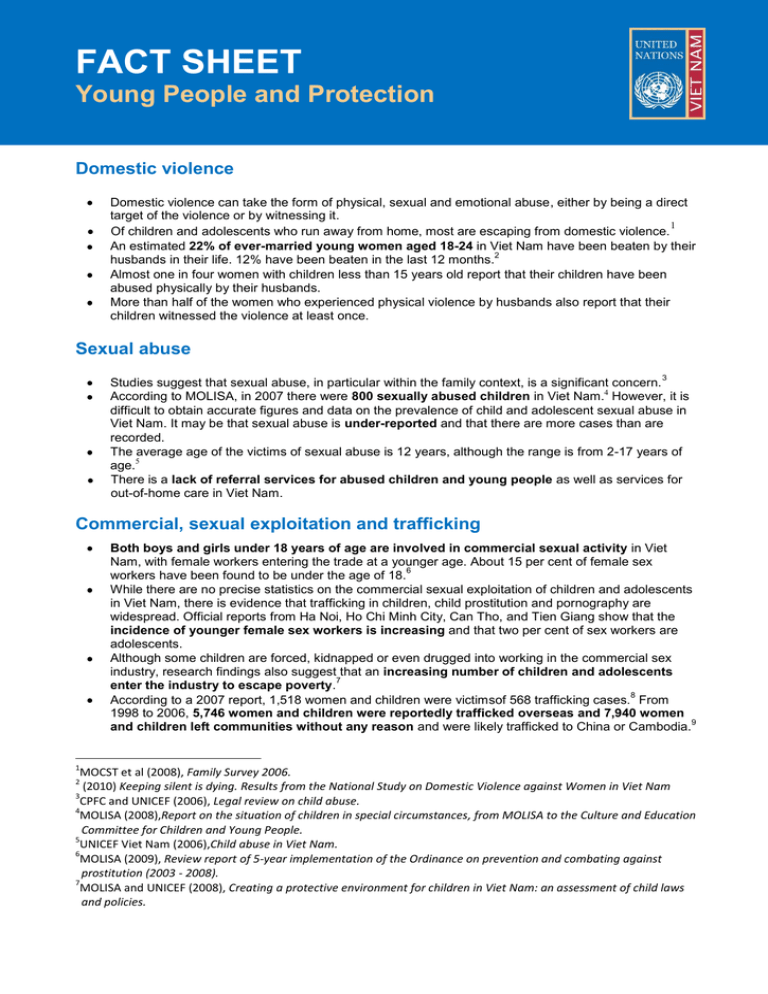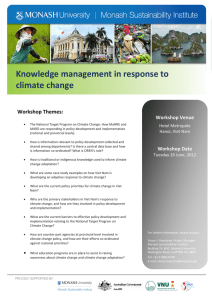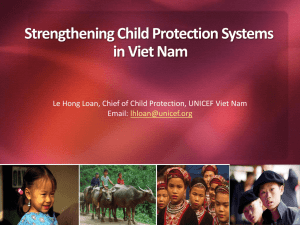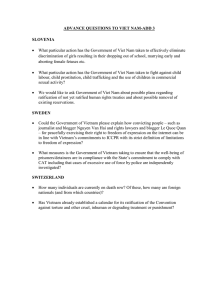View - The United Nations in Vietnam
advertisement

FACT SHEET Young People and Protection Domestic violence Domestic violence can take the form of physical, sexual and emotional abuse, either by being a direct target of the violence or by witnessing it. 1 Of children and adolescents who run away from home, most are escaping from domestic violence. An estimated 22% of ever-married young women aged 18-24 in Viet Nam have been beaten by their 2 husbands in their life. 12% have been beaten in the last 12 months. Almost one in four women with children less than 15 years old report that their children have been abused physically by their husbands. More than half of the women who experienced physical violence by husbands also report that their children witnessed the violence at least once. Sexual abuse 3 Studies suggest that sexual abuse, in particular within the family context, is a significant concern. According to MOLISA, in 2007 there were 800 sexually abused children in Viet Nam.4 However, it is difficult to obtain accurate figures and data on the prevalence of child and adolescent sexual abuse in Viet Nam. It may be that sexual abuse is under-reported and that there are more cases than are recorded. The average age of the victims of sexual abuse is 12 years, although the range is from 2-17 years of age.5 There is a lack of referral services for abused children and young people as well as services for out-of-home care in Viet Nam. Commercial, sexual exploitation and trafficking Both boys and girls under 18 years of age are involved in commercial sexual activity in Viet Nam, with female workers entering the trade at a younger age. About 15 per cent of female sex 6 workers have been found to be under the age of 18. While there are no precise statistics on the commercial sexual exploitation of children and adolescents in Viet Nam, there is evidence that trafficking in children, child prostitution and pornography are widespread. Official reports from Ha Noi, Ho Chi Minh City, Can Tho, and Tien Giang show that the incidence of younger female sex workers is increasing and that two per cent of sex workers are adolescents. Although some children are forced, kidnapped or even drugged into working in the commercial sex industry, research findings also suggest that an increasing number of children and adolescents 7 enter the industry to escape poverty. 8 According to a 2007 report, 1,518 women and children were victimsof 568 trafficking cases. From 1998 to 2006, 5,746 women and children were reportedly trafficked overseas and 7,940 women 9 and children left communities without any reason and were likely trafficked to China or Cambodia. 1 MOCST et al (2008), Family Survey 2006. (2010) Keeping silent is dying. Results from the National Study on Domestic Violence against Women in Viet Nam 3 CPFC and UNICEF (2006), Legal review on child abuse. 4 MOLISA (2008),Report on the situation of children in special circumstances, from MOLISA to the Culture and Education Committee for Children and Young People. 5 UNICEF Viet Nam (2006),Child abuse in Viet Nam. 6 MOLISA (2009), Review report of 5-year implementation of the Ordinance on prevention and combating against prostitution (2003 - 2008). 7 MOLISA and UNICEF (2008), Creating a protective environment for children in Viet Nam: an assessment of child laws and policies. 2 Children/adolescents involved in labour According to ILO criteria applied in its most recent study (undertaken by the Understanding Children’s Work project), almost 151,000 children below the absolute minimum working age of 12 years are involved in economic activity in Viet Nam; roughly 503,400 children and adolescents under 15 10 years are employed in heavy economic activity; and 633,400 children work excessive hours. 11 Boys and girls are involved in economic activity in almost equal numbers, and there is no particular gender bias in the type of work done. However, children in rural areas, older children, ethnic minority children and children who are not attending school are more likely to be working than children from other groups. The involvement in economic activities of children aged 10-14 declined from over 45 per cent of all 12 children in this age group in 1993 to under ten per cent in 2006. There is a severe shortage of professional social workers to care and support young people who suffer from, or are at risk of harm, abuse and exploitation and those in need of special protection. Young people in contact with the law Young people in contact with the law consist of juveniles in conflict with the law (i.e. juvenile offenders), as well as victims and witnesses of crime. 13 In 2009,the Ministry of Justice reported 15,589 juveniles in conflict with the law. The most common offences committed by juveniles are theft, purse snatching, disturbing public order, intentional 14 injury, appropriating assets by deception, drug addiction and robbery. The number of children and young people in contact with the law as victims or witnesses is also increasing, mostly as victims of child sexual and physical abuse, trafficking and kidnapping. The justice procedures are not always child-friendly and there is limited family support, social assistance and psycho-social care for children and young people in contact with the law. Recommendations Social protection systems should be strengthened and professional social and protection services should be equipped with the capacity to respond adequately to vulnerable children and young people. A ‘continuum of services’ should be established to assure protection and welfare of childrenand young peopleat all times and at all levels. A clear mechanism for prevention, early detection and identification of vulnerable children and at-risk families needs to be developed, and early intervention and referral to existing specialized services needs to be systematized. Alternative care models for at-risk and disadvantaged children and young people should be expanded. The justice system should introduce more child-friendly procedures and mechanisms for children and young people in contact with the law. Aspecialized agency or separate procedures should be established for investigating child and young people abuse complaints. A system should be established to generate reliable national data on various child protection issues, so the number of children and young people who are abused, trafficked or sexually exploited is known. 8 MPS (2007), Review report of the Steering Committee 130/CP on the implementation of the National Plan of Action against Trafficking in Women and Children (2004 - 2006). 9 Ibid. 10 UNICEF (2010), An Analysis of the Situation of Children in Viet Nam 11 ILO et al. (2009),Understanding Children’s Work in Viet Nam. 12 UNICEF (2010), An Analysis of the Situation of Children in Viet Nam. 13 Ibid. 14 Ibid. UNITED NATIONS VIET NAM Add: No. 25 - 29, PhanBoiChau, HoanKiem, Ha Noi| Tel: +84 4 39421495 | Fax: +84 4 3942 2267 Email: communications.vn@one.un.org |Web: http://vn.one.un.org



